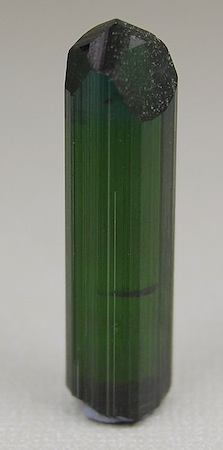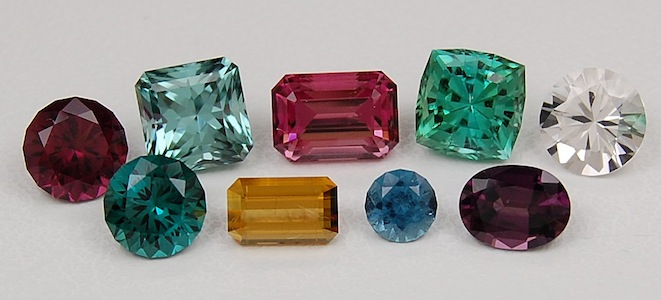

Introduction: The term “tourmaline” is mostly used in the gem trade to describe a widely used, beautiful and popular gemstone. In reality,tourmaline is not one type of gemstone but a family of closely related minerals, all having the same crystal structure but varying greatly in chemical composition, color and properties. There are currently 25 end-member mineral species within the group that are recognized by the IMA (International Mineralogical Association). Most tourmaline gems exist in the group within the species of elbaite, liddicoatite or dravite. These species names are not commonly used by gemologists. Instead, many varietal names which mostly refer to color are commonly seen. They are:
Rubellite: Pink to red sometimes with brownish or orange secondary colors.
Verdelite: Green tourmalines with yellow or blue secondary colors. This varietal name is not often used but rather the gems are referred to as green tourmaline, blue-green tourmaline, etc.
Indicolite: Blue to greenish blue
Achroite: Colorless
Dravite: Yellow to brown colors even though some of these gems may not mineralogically belong to the dravite species.
Bicolor: Two colors within one gemstone. If more than two colors are present, the term parti-colored has been used.
Watermelon: Usually tourmaline crystal slices with pink in the center and green around the edges.
Chrome: Intense chrome green color and a variety of the species dravite. The chromophore in this variety is either chromium or vanadium.
Cat’s Eye: Hollow growth tubes oriented properly during cabochon cutting causes this phenomenal affect.
Liddicoatite: One of the “newer” tourmaline species officially recognized in 1977. It is named after Richard T. Liddicoat, one of GIA’s founding fathers. Although liddicoatite gems can be faceted, they are most often seen as crystal slices with various zoned colors in geometric patterns.
Purple: One of the newly discovered colors of tourmaline found as a cuprian bearing tourmaline from Mozambique.
Paraiba: The original variety referred to cuprian or “copper bearing” tourmalines from Paraiba, Brazil. Subsequent finds of cuprian tourmalines in Mozambique and Nigeria have clouded the use of the term Paraiba. As a matter of personal opinion, these tourmalines should be referred to as cuprian tourmalines,reserving the term “Paraiba” for those tourmalines that originate from their source in Brazil. Currently, lab reports may refer to cuprian tourmalines from Mozambique or Nigeria as “Paraiba-type” or “Paraiba-like”.
.jpg)
Clarity: Most tourmaline gemstones are of Type II clarity. Gems of this type typically grow with some minor inclusions in nature that may be eye visible but usually are well hidden or require magnification.
Oddly enough, green, blue-green and chrome tourmalines are of Type I clarity. By definition, gems of this type grow extremely clean in nature and usually have no eye visible inclusions. Tourmalines frequently contain threadlike liquid and gas inclusions, sometimes as two phase inclusions. These inclusions can occur singly or in dense meshlike patterns. Tubes usually run parallel to the length of the crystal. Among the mineral inclusions identified in tourmalines are apatite, diopside, sphene, uraninite, copper, muscovite and zircon.
Stone Sizes: With such a vast array of colors, chemical compositions and localities, it is not surprising that there have been tourmaline gems cut in the 100 ct+ range. North America’s largest faceted
tourmaline weighs 256 carats. It is a rich green color from Mt. Mica in Paris, Maine, mined by the Plumbago Mining Company in the late 1970’s and cut as an emerald cut by Art Grant of Coast to Coast Rare Stones. Commercially, typical sizes of tourmalines are less than 20 carats. Chrome tourmaline and yellow tourmaline don’t often exceed 10 carats and tourmalines from Paraiba, Brazil are considered large
if they weigh more than 3 carats.
Localities: Gem tourmalines are found in many localities worldwide. Some of the better known sources are:
-Brazil: An important source of gem tourmaline from Minas Gerais as well as other states. Greens, blues and pinks are regularly seen. Particularly notable are the intense cranberry reds from the Jonas Mine.
The Paraiba district is well known for it’s fantastic copper bearing tourmalines in vibrant if not electric greens and neon “Windex” blues
-Namibia: Although there is currently not a lot of production from Namibia, it has and still does yield some fantastic stones. The famous locality at Neu Schwaben and Omapyo are perhaps two of the better known locales.
-Afghanistan: Exceptional stones from Nuristan in shades of green, blue and pink are well known. Rough material is usually taken to Peshawar, Pakistan for sale to the international market.
-Nigeria: Many localities in Nigeria have produced greens, pinks and reds. Large quantities of the pink and red material were available in the market in the 1990’s but this material has long since been swallowed up in the market. There is also a minor amount of cuprian bearing tourmaline found in the country.
-Madagascar: Liddicoatite is the best known tourmaline from this country. It was originally identified as elbaite but identified as it’s own species in 1977. (see above under varieties for additional info).-Sri Lanka: This was the original source of tourmaline. It was found as yellow and brown crystals and later identified as the species uvite.
-United States: Mt Mica in Paris, Maine was the original source of gem tourmaline in the United States, first found in 1820 and still producing today. Mt Mica produces a wide range of colors but primarily greens and blues and a smattering of smaller pinks. Cranberry reds, mint greens and bicolors are well known from Newry, Maine. The large find in the early 1970’s supplied material to the trade for many years. Pink tourmalines from the Pala District in California are a unique pastel shade. Fine, small green tourmalines have been found from time to time at Haddam, Connecticut.
Treatments:
-Heating (H) is done to improve color. Darker greens and blues can sometimes be lightened to lighter green and blue-green colors. It is commonly done and undetectable. The stability and durability is
excellent. Heating pinks and reds is usually done to burn off the undesirable brown overtones. It is undetectable and stable. If too much temperature is applied or for too long a period of time when heating
pinks or reds, the stones will convert to colorless. In cuprian elbaites, heating changes purple colored tourmalines to strongly colored greens, green-blues and blues. It is commonly done and stable.
-Irradiation (R) is done to improve color. Gamma irradiation of colorless stones will produce a deep pink to red color. It is common, undetectable and stable.
Gemology:
-Refractive Index: 1.624-1.644 (+0.011, -0.009)
-Birefringence: 0.018-0.040, usually around 0.020
-Optic Character: Doubly refractive, uniaxial negative
-Dispersion: 0.017
-Specific Gravity: 3.06 (+0.20, -0.06)
Hardness: 7-7.5
-Toughness: good, although susceptible to breaking with sudden temperature changes
-Chemical Composition: (Ca,K,Na)(AL,Fe,Li,Mg,Mn)3(Al,Cr,Fe,V)6(BO3)Si6O18(OH,F)4 The many colors of tourmaline are due to a complexity of chemical composition. John Ruskin, the English art critic and
philanthropist once quipped in 1890 that “the chemistry of tourmaline is more like a medieval doctor’s prescription than the making of a respectable mineral.”
-Cause of Color:
Green - Iron
Chrome Green - Chromium and/or vanadium
Blue - Iron
Pink - Manganese
-Absorption Spectra: Blue and green have almost complete absorption of the red down to 640 nm in addition to a stron narrow band at 498 nm. Reds and pinks have a broad band in the green and lines at
458 and 451 nm.
-Fluorescence: Pinks are inert to very weak red in LW and SW. All other colors are inert.Cleavage: None
-Phenomena: Chatoyancy
Name: Tourmaline is from the Sinhalese word turmali, meaning mixed color. Tourmalines were often confused with other gems.
Dates: Tourmaline is the birthstone for the month of October.
Care: Tourmaline may be safely cleaned with warm, soapy water. Ultrasonic and steam cleaners are risky in terms of breakage due to sudden temperature changes and not recommended.
To see available tourmalines by color, click on the tourmaline color..Blue..Brown..Green..Pink..Yellow
To see all available tourmalines at the same time, type the word tourmaline into the search box and click go.
